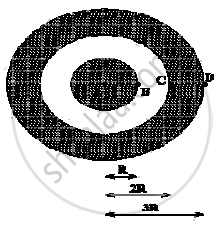Advertisements
Advertisements
Question
Define electrostatic potential at a point. Write its S.I. unit. Three-point charges q1, q2 and q3 are kept respectively at points A, B, and C as shown in the figure, Derive the expression for the electrostatic potential energy of the system.

Solution
The electrostatic potential (V ) at any point in a region with electrostatic field is the work done in bringing a unit positive charge (without acceleration) from infinity to that point. Its S.I. unit is Volt. The potential energy of a system of three charges q1, q2, and q3 located at `vec"r"_1,vec"r"_2,vec"r"_3,`respectively. To bring q1 first from infinity to `vecr_1`, no work is required. Next, we bring q2 from infinity to `vec r_2`,. As before, work done in this step is
`q_2"V"_1(vecr_2,)= (1)/(4piepsilon_0) (q_1q_2)/"r"_12` ...(1)
The charges q1and q2 produce a potential, which at any point P is given by
`"V"_(1,2) = (1)/(4piepsilon_0)(q_1/"r"_(1"P") + q_2/"r"_(2"P"))` .......(2)
Work done next in bringing q3 from infinity to the point `vec"r"_3 "is q3 times V1, 2 at"`
`q_3"V"_(1,2) (vec"r"_3) = (1)/(4piepsilon_0)((q_1q_2)/"r"_12+ (q_2q_3)/"r"_23)` ...(3)
The total work done in assembling the charges at the given locations is obtained by adding the work done in different steps [Eq. (1) and Eq. (3)] and gets stored in the form of potential energy.
`"U" = (1)/(4piepsilon_0) ((q_1q_2)/"r"_12 + (q_1q_3)/"r"_13 + (q_2q_3)/"r"_23)`.
APPEARS IN
RELATED QUESTIONS
A spherical conducting shell of inner radius r1 and outer radius r2 has a charge Q.
(a) A charge q is placed at the centre of the shell. What is the surface charge density on the inner and outer surfaces of the shell?
(b) Is the electric field inside a cavity (with no charge) zero, even if the shell is not spherical, but has any irregular shape? Explain.
A 12 pF capacitor is connected to a 50 V battery. How much electrostatic energy is stored in the capacitor? If another capacitor of 6 pF is connected in series with it with the same battery connected across the combination, find the charge stored and potential difference across each capacitor.
Fill in the blank.
A point charge is placed at the centre of a hollow conducting sphere of internal radius 'r' and outer radius '2r'. The ratio of the surface charge density of the inner surface to that of the outer surface will be_________.
Electric-field magnitude 'E' at points inside and outside a positively charged spherical conductor having charge Q and a radius R are ______.
If R is the radius of a spherical conductor, Vm the dielectric strength, then the maximum electric-field magnitude to which it can be raised is ______.
The electrostatic potential on the surface of a charged conducting sphere is 100V. Two statements are made in this regard S1 at any point inside the sphere, electric intensity is zero. S2 at any point inside the sphere, the electrostatic potential is 100 V. Which of the following is a correct statement?
A solid spherical conductor has charge +Q and radius R. It is surrounded by a solid spherical shell with charge -Q, inner radius 2R, and outer radius 3R. Which of the following statements is true?

Consider a finite insulated, uncharged conductor placed near a finite positively charged conductor. The uncharged body must have a potential:
